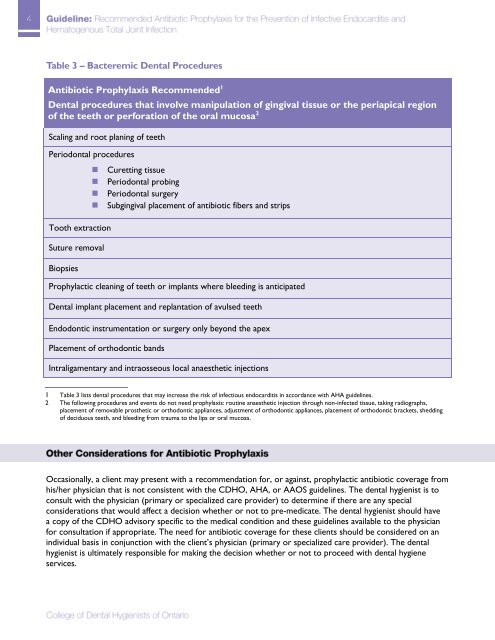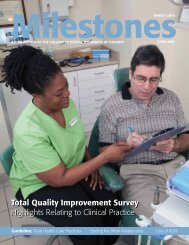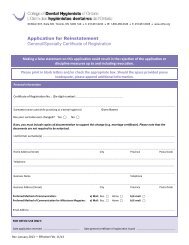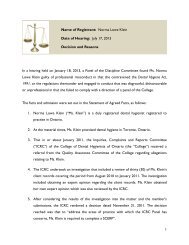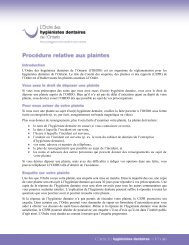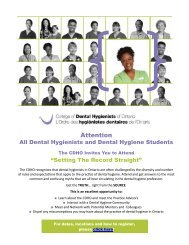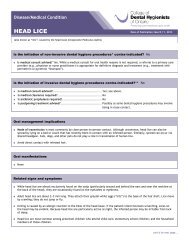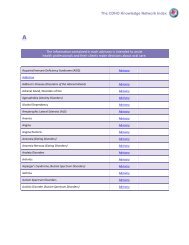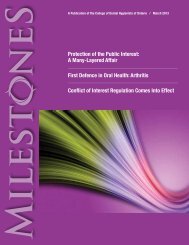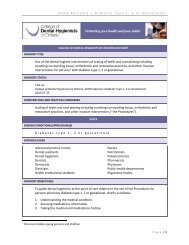Recommended Antibiotic Prophylaxis for the Prevention - College Of ...
Recommended Antibiotic Prophylaxis for the Prevention - College Of ...
Recommended Antibiotic Prophylaxis for the Prevention - College Of ...
Create successful ePaper yourself
Turn your PDF publications into a flip-book with our unique Google optimized e-Paper software.
Table 3 – Bacteremic Dental Procedures<br />
<strong>Antibiotic</strong> <strong>Prophylaxis</strong> <strong>Recommended</strong> 1<br />
Dental procedures that involve manipulation of gingival tissue or <strong>the</strong> periapical region<br />
of <strong>the</strong> teeth or per<strong>for</strong>ation of <strong>the</strong> oral mucosa 2<br />
Scaling and root planing of teeth<br />
Periodontal procedures<br />
Tooth extraction<br />
Suture removal<br />
Biopsies<br />
•Curetting tissue<br />
•Periodontal probing<br />
•Periodontal surgery<br />
•Subgingival placement of antibiotic fibers and strips<br />
Prophylactic cleaning of teeth or implants where bleeding is anticipated<br />
Dental implant placement and replantation of avulsed teeth<br />
Endodontic instrumentation or surgery only beyond <strong>the</strong> apex<br />
Placement of orthodontic bands<br />
Intraligamentary and intraosseous local anaes<strong>the</strong>tic injections<br />
1 Table 3 lists dental procedures that may increase <strong>the</strong> risk of infectious endocarditis in accordance with AHA guidelines.<br />
2 The following procedures and events do not need prophylaxis: routine anaes<strong>the</strong>tic injection through non-infected tissue, taking radiographs,<br />
placement of removable pros<strong>the</strong>tic or orthodontic appliances, adjustment of orthodontic appliances, placement of orthodontic brackets, shedding<br />
of deciduous teeth, and bleeding from trauma to <strong>the</strong> lips or oral mucosa.<br />
Occasionally, a client may present with a recommendation <strong>for</strong>, or against, prophylactic antibiotic coverage from<br />
his/her physician that is not consistent with <strong>the</strong> CDHO, AHA, or AAOS guidelines. The dental hygienist is to<br />
consult with <strong>the</strong> physician (primary or specialized care provider) to determine if <strong>the</strong>re are any special<br />
considerations that would affect a decision whe<strong>the</strong>r or not to pre-medicate. The dental hygienist should have<br />
a copy of <strong>the</strong> CDHO advisory specific to <strong>the</strong> medical condition and <strong>the</strong>se guidelines available to <strong>the</strong> physician<br />
<strong>for</strong> consultation if appropriate. The need <strong>for</strong> antibiotic coverage <strong>for</strong> <strong>the</strong>se clients should be considered on an<br />
individual basis in conjunction with <strong>the</strong> client’s physician (primary or specialized care provider). The dental<br />
hygienist is ultimately responsible <strong>for</strong> making <strong>the</strong> decision whe<strong>the</strong>r or not to proceed with dental hygiene<br />
services.


